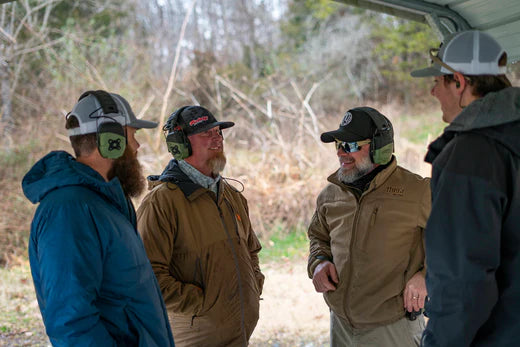Four tips for communicating on the range
ISOtunes Sport Team / May 3, 2021
For shooters, there are few things worse than the inability to communicate. This is true in life, in battle, and even on the shooting range. We’ve all probably seen it - someone goes to the range and “forgets” their hearing protection, acting like they’re too tough to need it. They then proceed to spend the rest of the afternoon shouting “What?!” every time you attempt to have a conversation.
It can be a fine balance between protecting your hearing and still being able to communicate, particularly with old technology. *Cough foam earplugs cough. But what if you could actually have both? What if you didn't have to sacrifice protecting your hearing in order to communicate? Let’s look at some tips that may help you communicate with your crew and lane neighbors on your next visit to the gun range.
1. quality hearing protection
This is obvious, and you’d rightfully expect to see this on our page. Great hearing protection options do exist (click here for proof) and can make your time at the range significantly more enjoyable. Seek out a product that offers a high amount of noise reduction (NRR), improves your ability to communicate at low volumes, and includes other features that may be important for your style and preferences (like Tactical Sound Control™ Technology).
2. understand basic rules and signals
Following posted signage at the range is a no brainer, but we all could use the reminder at times. If you visit your range as often as we do, you may be numb to the signs and rules. Take a minute each time you visit to refamiliarize yourself with the operations and protocols of the range. Another great idea is to plug into the shooting community and understand the dynamic at your local range. Are there any other understood rules or practices that will prevent you from feeling like a newbie? Consider going with someone more seasoned for the first couple times and shadow them, asking questions if necessary. And don’t be shy about coaching someone else who may be looking for a little guidance.
3. plan and download
Like many situations involving firearms, a good prep meeting goes a long way. This holds especially true if you’re bringing young, inexperienced shooters to the range or if you’re somewhat inexperienced yourself. Connect with those around you outside the shooting area before stepping into the box. What can we expect to see, hear, and experience? Likewise, don’t miss the opportunity to offer feedback when the session is over, whether it’s in the car, over lunch or a cold beer, or just hanging out cleaning gear and putting equipment away before jumping in your separate trucks. Take advantage of teaching opportunities or reminders while things are fresh. Cover any dangerous or questionable behavior that should be adjusted in the future. hit on any reminders if there was dangerous or questionable behavior.
4. have fun, but do it seriously
This one may seem a bit too obvious, but there’s a distinct difference in having fun, and having serious fun. At the end of the day, it’s the goal for everyone to go home in the same shape they arrived. Shooting at the range can be a great muse, great practice, and even therapy for some, but that doesn’t change the fact that there’s an inherent danger in being around firearms (especially if the range is busy or there are folks around that you don’t know well). Everyone’s skill set and comfort level with firearms is different. Have fun, for sure, but don’t forget that it’s a situation where others may not be as cool, calm, and collected. Take the fun seriously, be alert and aware, and make sure those around you are all OK with each other.
join the conversation
What other communication tips would you share?
Learn more about how ISOtunes products use Tactical Sound Control™ Technology to improve communication at the range.



